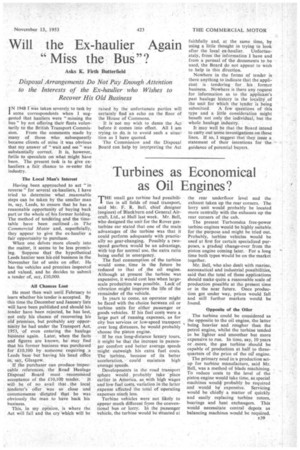Turbines as Economical as Oil Engines?
Page 145

If you've noticed an error in this article please click here to report it so we can fix it.
THE small gas turbine had possibilities in all fields of road transport, said Mr, F. R. Bell, chief designer (engines) of Blackburn and General Aircraft, Ltd., at Hull last week. Mr. Bell, who designed the unit for the Rover gasturbine car stated that one of the main advantages of the turbine was that it could perform adequately with practically no gear-changing. Possibly a twospeed gearbox would be an advantage, with top for normal use, the extra ratio being useful in emergency.
, The fuel consumption of the turbine would some time in the future be reduced to that of the oil engine. Although at present the turbine was expensive, it would cost less when largescale production was possible. LacX of vibration might improve the life of the remainder of the vehicle.
In years to come, an operator might be faced with the choice between oil or turbine units for either passenger or goods vehicles. If his fuel costs were a large part of running expenses, as for city bus services or low-speed transport over long distances, he would probably choose the piston engine.
If he ran long-distance luxury tours, it might be that the increase in passenger comfort and better average speeds might outweigh his extra fuel costs. The turbine, because of . its better acceleration, could maintain high average speeds. • Developments in the road transport sphere would probably take 'place earlier in America, as, with high wages and low fuel costs, variation in the latter expense affected the total = of operating expenses much less.
Turbine vehicles were not likely to appear much different from the conventional bus or lorry. In the passenger vehicle, the turbine would be situated at the rear underfloor level and the exhaust taken up the rear corners. The lorry Unit would probably be located more centrally with the exhausts up the rear corners of the cab.
The present Turbom&a free-power turbine engines would be highly suitable for the purpose and might be tried out. Probably, turbine vehicles would be used at first for certain specialized purposes, a gradual change-over from the piston engine corning later. For a long time both types would be on the market together.
Mr. Bell, who also dealt with marine, aeronautical and industrial possibilities, said that the total of these applications should make quite a reasonable scale of production possible at the present time or in the near future. Once production got under way, prices would fall and still further markets would be found.
Opposite of the Oiler The turbine could be considered as the opposite to the oil engine, the latter ' being heavier and rougher than the petrol engine, whilst the turbine tended to be lighter and smoother but more expensive to run. In time, say, 10 years or more, the gas turbine should be capable of production at half to threequarters of the price of the °A engine.
The primary need in a production setup for turbine manufacture, said Mr. Bell, was a method of blade machining. TO reduce costs to the level of the piston engine would take time, as special machines would probably be required and would be expensive. Servicing would be chiefly a matter of quickly and easily replacing turbine rotors, bearings and heat exchangers. This would necessitate central depots as balancing machines would be required.












































































































































































































































